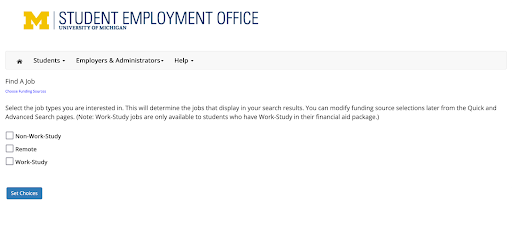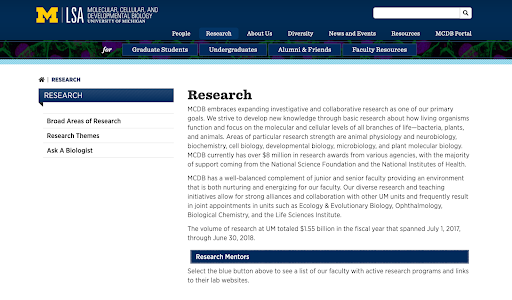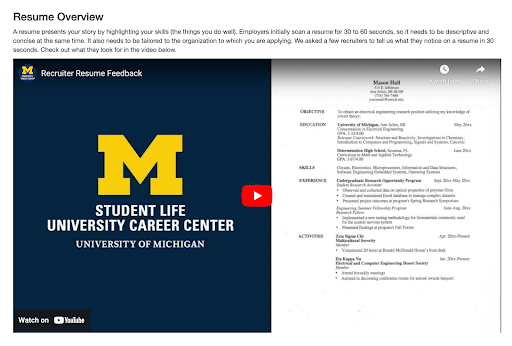Blog
Get the inside scoop about life at U-M and applying to Michigan from current student bloggers, Admissions staff, and guest faculty writers.

Get the inside scoop about life at U-M and applying to Michigan from current student bloggers, Admissions staff, and guest faculty writers.

Resources and tips for getting involved in research I wish I knew about earlier.

As a senior at the University of Michigan, I have a lot to be grateful for as I get ready to say goodbye to my undergraduate years and greet the era that lies ahead. Reflecting on my almost three and a half years at U-M, I am particularly thankful for the opportunity to get involved in research at a top institution and pursue my interests in an experiential setting, pushing me to grow not only as a researcher but also as a student and person.
To those of you who may be interested in pursuing research, no matter what field, there is something for you here. I want to pass along some resources and tips for getting involved in research that I wish I had known about earlier or have found helpful during my time here at the university.
The Undergraduate Research Opportunity Program, also known as UROP, is a program for first-year and second-year students to gain research experience for the first time. UROP introduces students to different fields of research, ranging from the health sciences to the humanities, through biweekly research seminars and a wide array of research projects that students can apply to at the beginning of the year. As a former UROP student, I thought this program was an excellent way to identify my research interests and partner with a research mentor in a structured format so that I felt supported every step of the way. The UROP application can be found online when it’s active, along with information about other UROP programs, including the Changing Gears Program and the Community-Engaged Research Program.

The U-M Student Employment Office is another great place to look for more information about ways to get involved in research. This office offers both Work-Study and non-Work-Study opportunities for students. Work-Study jobs are available to U-M students who were awarded Work-Study funding after applying for financial aid. Non-Work-Study jobs are available to all U-M students regardless of financial aid status. Periodically, this office will update its website with new job opportunities, including student research positions. I wish I knew about this resource earlier, and I highly recommend taking a look – whether it is for research or other employment options on campus.

If you already have a specific research interest in mind, I encourage you to look into the various university departments to see what discipline your interests may fall under. For example, if you are curious about cell biology and want to gain hands-on experience in a wet lab setting, you could try exploring the Department of Molecular, Cellular, & Developmental Biology homepage to see if your interests align with the department’s work. Department websites should have a “Faculty” page where you can see information about faculty members who may be involved in research on campus along with their email addresses. Feel free to reach out to them if you would like to get involved in the work they or do or something similar. Some department websites may also have a “Research” page, such as the one pictured below, where research mentors and their lab information is listed so you can get a better idea of the work they do and ways to get involved. Don’t forget that your professors can be a great resource to learn more about research and may be involved in research themselves, so don’t hesitate to reach out to them as well!

When reaching out to faculty or research mentors about getting involved in research, you often will need to share your interests and qualifications with them to introduce yourself and why you would be a good fit for their project or research lab. This can be accomplished through a resume and cover letter! You may ask, what is a resume? Or, what is a cover letter? A resume is usually a one-page summary of your experiences and skills that give your reader a better idea of who you are and what you are interested in. A cover letter is an application (usually in email form) that you send along with your resume to introduce yourself and highlight your skills and interest in the opportunity you are applying for. The University Career Center offers extremely helpful resume and cover letter resources, as well as samples for each.

I hope you found these resources helpful as you think about getting involved in research at the university. If you have the slightest interest in getting involved, I would go for it! You have everything to gain and nothing to lose by reaching out to a faculty member or applying for a research project. You may pick up some useful skills on the way. Good luck!

Madeleine Lee is a senior in the College of Literature, Science, and the Arts with plans to work at the intersection of health and social justice. Outside of the classroom, she conducts research at the Kellogg Eye Center and is a member of the Korean-American Scientists and Engineers Association. She is an Ann Arbor native, and in her free time, you can find her running, solving crossword puzzles, or making playlists.